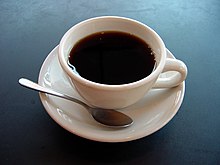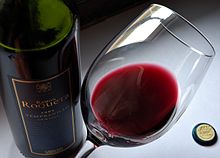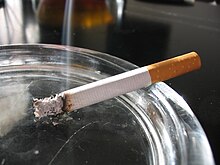| Revision as of 01:52, 15 April 2014 view sourceBattyBot (talk | contribs)Bots1,935,109 editsm fixed CS1 errors: dates to meet MOS:DATEFORMAT (also General fixes) using AWB (10069)← Previous edit | Revision as of 00:16, 2 May 2014 view source Levelledout (talk | contribs)Extended confirmed users1,042 edits Improve / clean up introductionNext edit → | ||
| Line 2: | Line 2: | ||
| {{Hatnote|For the act after using drugs, see ].}} | {{Hatnote|For the act after using drugs, see ].}} | ||
| {{pp-semi-indef|small=yes|expiry=December 21, 2008}} | {{pp-semi-indef|small=yes|expiry=December 21, 2008}} | ||
| ] is the most widely used ] |
], contained in coffee and other beverages, is the most widely used ] in the world. 90% of adults consume the substance on a daily basis in North America.<ref name="New Scientist: Coffee: The demon drink?">{{cite web | url = http://www.newscientist.com/article/mg18725181.700 | title = Coffee: The demon drink? | accessdate = 2014-05-01 | author = Richard Lovett | date = 2005-09-24 | format = html | language = English }}</ref>]] | ||
| ] is a common ].<ref>In Germany about 118 l of ], 20 l of ], 4 l of ] and 6 l of ]s are consumed per person per year.{{Citation needed|date=November 2009}}</ref>]] | ] is a common ].<ref>In Germany about 118 l of ], 20 l of ], 4 l of ] and 6 l of ]s are consumed per person per year.{{Citation needed|date=November 2009}}</ref>]] | ||
| <!-- Please cite reliable sources, according to Misplaced Pages guidelines, for any new information. --> | <!-- Please cite reliable sources, according to Misplaced Pages guidelines, for any new information. --> | ||
| A '''drug''' is a ] |
A '''drug''' is a ] that has known ] or ] effects on ] and other ] and is not considered a ] or exclusively a food.<ref name="diccom"> ''Dictionary.com Unabridged (v 1.1)'', ], via dictionary.com. Retrieved on 20 September 2007.</ref> | ||
| In ], a drug is "a ] substance used in the treatment, cure, prevention, or diagnosis of disease or used to otherwise enhance physical or mental well-being."<ref name="diccom" /> Drugs may be used for a limited duration, or on a regular basis for ].<ref name="ahsci"> ''The American Heritage Science Dictionary'', ], via dictionary.com. Retrieved on 20 September 2007.</ref> | |||
| ] are chemical substances that affect the ], such as ]s or ]s.<ref name="ahsci" /> They may be used for effects on ], ], ], and ].<ref name="ahsci" /><ref name="mwmed"> ''Merriam-Webster's Medical Dictionary'', Merriam-Webster, Inc., via dictionary.com. Retrieved on 20 September 2007.</ref> Some drugs can cause ] and/or habituation.<ref name="mwmed" /> | |||
| ⚫ | Drugs are usually distinguished from ] biochemicals by being introduced from outside the organism.{{Citation needed|date=November 2009}} For example, ] is a hormone that is synthesized in the body; it is called a hormone when it is synthesized by the pancreas inside the body, but if it is introduced into the body from outside, it is referred to as a drug.{{Citation needed|date=November 2009}} | ||
| ] are chemical substances that affect the ], such as ]s or ]s.<ref name="ahsci" /> They may be used for perceived beneficial effects on ], ], ], and ].<ref name="ahsci" /><ref name="mwmed"> ''Merriam-Webster's Medical Dictionary'', Merriam-Webster, Inc., via dictionary.com. Retrieved on 20 September 2007.</ref> Some drugs can cause ] and/or habituation.<ref name="mwmed" /> | |||
| ⚫ | Many natural substances, such as ]s, ]s, and ], blur the line between food and recreational drugs, as when ingested they affect the functioning of both ] and ] and some substances normally considered drugs such as ] (Dimethyltryptamine) are actually produced by the human body in trace amounts.{{Citation needed|date=May 2014}} Consequently cultural and legal variations exist regarding both the precise definition of a drug and the distinction between a drug and a food.{{Citation needed|date=May 2014}} | ||
| ⚫ | Drugs are usually distinguished from ] biochemicals by being introduced from outside the organism.{{Citation needed|date=November 2009}} For example, ] is a hormone that is synthesized in the body; it is called a hormone when it is synthesized by the pancreas inside the body, but if it is introduced into the body from outside, it is |
||
| ⚫ | Many natural substances, such as ]s, ]s, and ], blur the line between food and recreational drugs, as when ingested they affect the functioning of both ] and ] and some substances normally considered drugs such as ] (Dimethyltryptamine) are actually produced by the human body in trace amounts. | ||
| == Etymology == | == Etymology == | ||
Revision as of 00:16, 2 May 2014
For other uses, see Drug (disambiguation). For the act after using drugs, see drunk.


A drug is a substance that has known medicinal or recreational effects on humans and other animals and is not considered a food or exclusively a food.
In pharmacology, a drug is "a chemical substance used in the treatment, cure, prevention, or diagnosis of disease or used to otherwise enhance physical or mental well-being." Drugs may be used for a limited duration, or on a regular basis for chronic disorders.
Recreational drugs are chemical substances that affect the central nervous system, such as opioids or hallucinogens. They may be used for effects on perception, consciousness, personality, and behavior. Some drugs can cause addiction and/or habituation.
Drugs are usually distinguished from endogenous biochemicals by being introduced from outside the organism. For example, insulin is a hormone that is synthesized in the body; it is called a hormone when it is synthesized by the pancreas inside the body, but if it is introduced into the body from outside, it is referred to as a drug.
Many natural substances, such as beers, wines, and psychoactive mushrooms, blur the line between food and recreational drugs, as when ingested they affect the functioning of both mind and body and some substances normally considered drugs such as DMT (Dimethyltryptamine) are actually produced by the human body in trace amounts. Consequently cultural and legal variations exist regarding both the precise definition of a drug and the distinction between a drug and a food.
Etymology
In English, the noun "drug" is thought to originate from Old French "drogue", possibly deriving later into "droge-vate" from Middle Dutch meaning "dry barrels", referring to medicinal plants preserved in them. The transitive verb "to drug" (meaning intentionally administer a substance to someone, often without their knowledge) arose later and invokes the psychoactive rather than medicinal properties of a substance.
Medication

(esomeprazole magnesium)
A medication or medicine is a drug taken to cure and/or ameliorate any symptoms of an illness or medical condition, or may be used as preventive medicine that has future benefits but does not treat any existing or pre-existing diseases or symptoms.
Dispensing of medication is often regulated by governments into three categories—over-the-counter (OTC) medications, which are available in pharmacies and supermarkets without special restrictions, behind-the-counter (BTC), which are dispensed by a pharmacist without needing a doctor's prescription, and prescription only medicines (POM), which must be prescribed by a licensed medical professional, usually a physician.
In the United Kingdom, BTC medicines are called pharmacy medicines which can only be sold in registered pharmacies, by or under the supervision of a pharmacist. These medications are designated by the letter P on the label. The range of medicines available without a prescription varies from country to country.
Medications are typically produced by pharmaceutical companies and are often patented to give the developer exclusive rights to produce them. Those that are not patented (or with expired patents) are called generic drugs since they can be produced by other companies without restrictions or licenses from the patent holder.
Spiritual and religious use
Main article: Entheogen
The spiritual and religious use of drugs has been occurring since the dawn of our species. Drugs that are considered to have spiritual or religious use are called entheogens. Some religions are based completely on the use of certain drugs. Entheogens are mostly hallucinogens, being either psychedelics or deliriants, but some are also stimulants and sedatives.
Self-improvement
Main article: NootropicNootropics, also commonly referred to as "smart drugs", are drugs that are claimed to improve human cognitive abilities. Nootropics are used to improve memory, concentration, thought, mood, learning, and many other things. Some nootropics are now beginning to be used to treat certain diseases such as attention-deficit hyperactivity disorder, Parkinson's disease, and Alzheimer's disease. They are also commonly used to regain brain function lost during aging. Similarly, drugs such as steroids improve human physical capabilities and are sometimes used (legally or not) for this purpose, often by professional athletes.
Recreational drug use


Recreational drugs use is the use of psychoactive substances to have fun, for the experience, or to enhance an already positive experience. National laws prohibit the use of many different recreational drugs and medicinal drugs that have the potential for recreational use are heavily regulated. Many other recreational drugs on the other hand are legal, widely culturally accepted, and at the most have an age restriction on using and/or purchasing them. These include alcohol, tobacco, betel nut, and caffeine products in the west, and in other localised areas of the world drugs such as Khat are common. Because of the legal status of many drugs, recreational drug use is controversial, with many governments not recognising spiritual or other perceived uses for drugs and classing them under illegal recreational use.
Administering drugs
Drugs, both medicinal and recreational, can be administered in a number of ways. Many drugs can be administered in a variety of ways rather than just one.
- Bolus is the administration of a medication, drug or other compound that is given to raise its concentration in blood to an effective level. The administration can be given intravenously, by intramuscular, intrathecal or subcutaneous injection.
- Inhaled, (breathed into the lungs), as an aerosol or dry powder. (This includes smoking a substance)
- Injected as a solution, suspension or emulsion either: intramuscular, intravenous, intraperitoneal, intraosseous.
- Insufflation, or snorted into the nose.
- Orally, as a liquid or solid, that is absorbed through the intestines.
- Rectally as a suppository, that is absorbed by the rectum or colon.
- Sublingually, diffusing into the blood through tissues under the tongue.
- Topically, usually as a cream or ointment. A drug administered in this manner may be given to act locally or systemically.
- Vaginally as a suppository, primarily to treat vaginal infections.
See also
- Drug development
- Drug injection
- Inverse benefit law
- Lifestyle drug
- List of drugs
- List of pharmaceutical companies
- List of psychedelic plants
- Placebo
- Prodrug
- United Nations Office on Drugs and Crime
References
- Richard Lovett (2005-09-24). "Coffee: The demon drink?" (html). Retrieved 2014-05-01.
- In Germany about 118 l of beer, 20 l of wine, 4 l of sparkling wine and 6 l of distilled beverages are consumed per person per year.
- ^ "Drug." Dictionary.com Unabridged (v 1.1), Random House, Inc., via dictionary.com. Retrieved on 20 September 2007.
- ^ "Drug." The American Heritage Science Dictionary, Houghton Mifflin Company, via dictionary.com. Retrieved on 20 September 2007.
- ^ "Drug." Merriam-Webster's Medical Dictionary, Merriam-Webster, Inc., via dictionary.com. Retrieved on 20 September 2007.
- Harper, Douglas. "drug". Online Etymology Dictionary.
- Tupper, K.W. (2012). Psychoactive substances and the English language: "Drugs," discourses, and public policy. Contemporary Drug Problems, 39(3), 461-492.
- "Glossary of MHRA terms - P". MHRA. Retrieved 2008-11-05.
- El-Seedi HR, De Smet PA, Beck O, Possnert G, Bruhn JG (October 2005). "Prehistoric peyote use: alkaloid analysis and radiocarbon dating of archaeological specimens of Lophophora from Texas". J Ethnopharmacol. 101 (1–3): 238–42. doi:10.1016/j.jep.2005.04.022. PMID 15990261.
{{cite journal}}: CS1 maint: multiple names: authors list (link) - Opler, Morris Edward (2008) . "The use of Peyote by the Carrizo and Lipan Apache tribes". American Ethnography Quasimonthly. Retrieved 19 January 2009.
- Schultes, Richard Evans (2008) . "The appeal of peyote (Lophophora Williamsii) as a medicine". American Ethnography Quasimonthly. Retrieved 19 January 2009.
- According to the statistic of the Food and Agriculture Organization the production quantity in 2006 of coffee was 7.8 million tonnes and of tobacco was 6.7 million tonnes.
- Lingeman, Drugs from A-Z A Dictionary, Penguin ISBN 0-7139-0136-5
- "?".
Further reading
- Richard J. Miller: Drugged: The Science and Culture Behind Psychotropic Drugs. Oxford University Press, 2014. ISBN 978-0-19-995797-2
External links
- DrugBank, a database of 4800 drugs and 2500 protein drug targets
| Major chemical drug groups – based upon the Anatomical Therapeutic Chemical Classification System | |
|---|---|
| gastrointestinal tract / metabolism (A) | |
| blood and blood forming organs (B) | |
| cardiovascular system (C) | |
| skin (D) | |
| genitourinary system (G) | |
| endocrine system (H) | |
| infections and infestations (J, P, QI) | |
| malignant disease (L01–L02) | |
| immune disease (L03–L04) | |
| muscles, bones, and joints (M) | |
| brain and nervous system (N) |
|
| respiratory system (R) | |
| sensory organs (S) | |
| other ATC (V) | |
| Hypnotics/sedatives (N05C) | |||||||||||||||||||||||||
|---|---|---|---|---|---|---|---|---|---|---|---|---|---|---|---|---|---|---|---|---|---|---|---|---|---|
| GABAA |
| ||||||||||||||||||||||||
| GABAB | |||||||||||||||||||||||||
| H1 |
| ||||||||||||||||||||||||
| α2-Adrenergic | |||||||||||||||||||||||||
| 5-HT2A |
| ||||||||||||||||||||||||
| Melatonin | |||||||||||||||||||||||||
| Orexin | |||||||||||||||||||||||||
| α2δ VDCC | |||||||||||||||||||||||||
| Others | |||||||||||||||||||||||||
| Hallucinogens | |||||||||||||||||||||||||||||||||||||||||||||||||||||||||||||||||||||||||
|---|---|---|---|---|---|---|---|---|---|---|---|---|---|---|---|---|---|---|---|---|---|---|---|---|---|---|---|---|---|---|---|---|---|---|---|---|---|---|---|---|---|---|---|---|---|---|---|---|---|---|---|---|---|---|---|---|---|---|---|---|---|---|---|---|---|---|---|---|---|---|---|---|---|
| Psychedelics (5-HT2A agonists) |
| ||||||||||||||||||||||||||||||||||||||||||||||||||||||||||||||||||||||||
| Dissociatives (NMDAR antagonists) |
| ||||||||||||||||||||||||||||||||||||||||||||||||||||||||||||||||||||||||
| Deliriants (mAChR antagonists) |
| ||||||||||||||||||||||||||||||||||||||||||||||||||||||||||||||||||||||||
| Others |
| ||||||||||||||||||||||||||||||||||||||||||||||||||||||||||||||||||||||||
| Stimulants | |
|---|---|
| Adamantanes | |
| Adenosine antagonists | |
| Alkylamines | |
| Ampakines | |
| Arylcyclohexylamines | |
| Benzazepines | |
| Cathinones |
|
| Cholinergics |
|
| Convulsants | |
| Eugeroics | |
| Oxazolines | |
| Phenethylamines |
|
| Phenylmorpholines | |
| Piperazines | |
| Piperidines |
|
| Pyrrolidines | |
| Racetams | |
| Tropanes |
|
| Tryptamines | |
| Others |
|
| ATC code: N06B | |